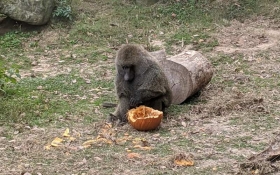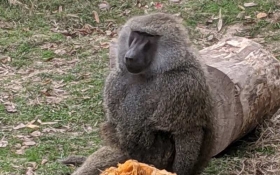
Olive Baboon
Papio anubis
Animal Behavior: Olive baboons live in a multi-male, multi-female troops which travel, forage and sleep together. An average troop may be comprised of 39 to 97 animals. They are quadrupedal, mainly terrestrial primates and are highly social animals. The average number of offspring is 1 weighing approximately 1068 g.
Eating Habits: Known to eat a wide variety of foods such as fruits, tree gums, insects, eggs, seeds, flowers, grass, rhizomes, corms, toots, tubers and small vertebrates.
Range: The olive baboon is the most broadly distributed baboon species, ranging through most of central sub-Saharan Africa. They are found in savannah, grassland steppe, and rainforest habitats. The daily range of a troop averages 5,800 m.
Conservation Efforts: The olive baboon is not considered threatened or endangered. Rated as "Lower Risk, Least Endangered."
Animal Facts: Anubis baboons are used in medical and behavioral research. They are socially active animals which provide entertainment for zoo visitors and ecotourists. The lifespan of the olive baboon has not been reported, but is likely to be similar to other species at 37 to 45 years, although somewhat shorter than these in the wild. Leopards and chimpanzees have been known to kill these animals.

